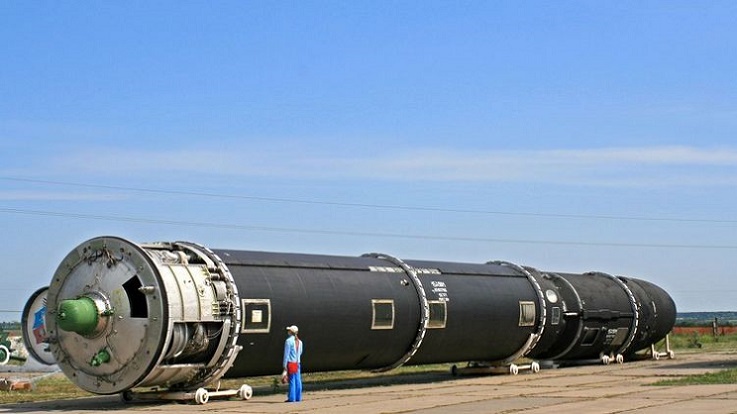
Putin Is Not Rattling Nuclear Sabers – It’s Real
By F. William Engdahl
6 March 2018
The annual speech of Russian President Vladimir Putin on March 1 to the Russian Federal Assembly, televised to the nation, contained a section on Russian military cutting edge technologies that NATO-friendly media chose to either downplay as a propaganda ploy or an election campaign stunt. Given the hints of Russian military technology developments unveiled in the Syrian war theater since September 2015, Washington ignores what is clearly a strategic game-breaking development and makes all the hundreds of billions of dollars of so-called US missile defense technology being deployed from South Korea, Japan, Poland and beyond into little more than a Pentagon defense boondoggle .
The military security section of Putin’s two hour speech to the Russian Federal Assembly on March 1 began some two-thirds into his remarks, after extensive discussions of plans to lift the economy, transform health care, improve education.
The keystone of Putin’s security remarks, ignored in mainstream western media coverage, was the Russian response has been to the “unilateral US withdrawal from the 1972 Anti-Ballistic Missile Treaty and the practical deployment of their missile defense systems both in the US and beyond their national borders.”
The strategic significance of that decision by the Bush-Cheney Administration was not lost on Russian military defense planners. It opened the door for the Pentagon and for NATO to encircle Russia with a ring of ballistic missile defense systems aimed at Russian nuclear missile launch sites. Putin clarified that that 1972 ABM Treaty had made nuclear war unthinkable, the foundation of Mutual and Assured Destruction or MAD: “the ABM Treaty not only created an atmosphere of trust but also prevented either party from recklessly using nuclear weapons, which would have endangered humankind, because the limited number of ballistic missile defense systems made the potential aggressor vulnerable to a response strike.”
When Washington unilaterally pulled out of the ABM Treaty in 2002, the US Government began an aggressive series of moves including bringing NATO to the former Communist countries of Eastern Europe, fomenting a coup and civil war in Ukraine and other provocations that have led to construction of anti-ballistic missile bases in Romania and Poland—both NATO members, as well as in the Russian Far East in Japan and South Korea. Additionally, as Putin noted, “The US global missile defense system also includes five cruisers and 30 destroyers, which, as far as we know, have been deployed to regions in close proximity to Russia’s borders.” This is no minor deployment in Russian eyes.
Trump Nuclear Posture Review
The decision by the Russian leadership now to unveil a daunting array of its cutting-edge military technologies including nuclear-powered hypersonic cruise missiles and underwater drones was no election ploy. It was a clear and direct reply to the January 2018 State of the Union address to Congress of the US President and publication days later of their 2018 Nuclear Posture Review (NPR), and Putin says so.
The Trump 2018 NPR document is a radical shift from previous administrations. It abandons the earlier declarations of “no first use” of nuclear weapons, and boosts nuclear modernization efforts including the intention to bring on “new” nuclear weapons, restoration of submarine-launched cruise missile capability and low-explosive-yield submarine-launched ballistic missile warheads, and to sideline arms control. In one section the new US Nuclear Posture Review declares that, “The United States would only consider the employment of nuclear weapons in extreme circumstances to defend the vital interests of the United States, its allies, and partners. Extreme circumstances could include significant non-nuclear strategic attacks…” (emphasis added-w.e.). No definition of what Washington calls a “significant non-nuclear strategic attack” is made. In brief, as one US nuclear analyst noted, the new US nuclear doctrine is based on competition and confrontation.
After describing repeated Russian efforts with Washington to reinstate the ABM Treaty after the Bush Administration unilaterally abandoned it in 2002, Putin noted, “At one point, I thought that a compromise was possible, but this was not to be. All our proposals, absolutely all of them, were rejected. And then we said that we would have to improve our modern strike systems to protect our security. In reply, the US said that it is not creating a global BMD system against Russia…”
That of course was a calculated strategic lie. Russia concluded, after repeated efforts at negotiation, that Washington, following the destruction of Russia’s military and economy in the 1990s Yeltsin era post-Soviet economic collapse, was determined to “pursue ultimate unilateral military advantage in order to dictate the terms in every sphere in the future.”
Nuclear Primacy
Nuclear First Strike or Nuclear Primacy as it is technically called, is the ultimate unilateral military advantage Pentagon strategists have dreamt of since the 1950’s when the USSR tested its first H-bomb and ICBMs. The primacy is the ability to launch a nuclear first strike against Russia with little fear Russia will be able to counter convincingly because US missile defense arrays have been able to knock out the vast majority of Russian nuclear weapons.
The US missile defense is not at all defensive. It is offensive in the extreme. If the United States were able to shield itself effectively from a potential Russian retaliation for a US nuclear First Strike, then the US would be able to dictate its terms to the entire world, not just to Russia. That would be Nuclear Primacy. As the late Lt. Colonel Robert Bowman, former director of the Reagan US Missile Defense Program expressed it to me some years ago in a private exchange, “Missile defense is the missing link to a First Strike.”
In his latest speech Putin describes the strategic reality Russian military security planners face: “The US is permitting constant, uncontrolled growth of the number of anti-ballistic missiles, improving their quality, and creating new missile launching areas. If we do not do something, eventually this will result in the complete devaluation of Russia’s nuclear potential. Meaning that all of our missiles could simply be intercepted.”
When the stakes involve unleashing a nuclear holocaust, even if it begins with “low yield” nuclear weapons, against a backdrop of virtual new Cold War confrontations with Russia in recent years, it is no surprise that Russia’s military and security council have decided at just this precarious point in a growing East-West confrontation to unveil a sober response.
Blocking Nuclear Primacy: The Russian Response
Putin unveiled for the first time measures the Russian military R&D has pursued quietly since 2002 to counter the ever-more clear US Nuclear Primacy agenda. He noted that Russia has “developed, and works continuously to perfect highly effective but modestly priced systems to overcome missile defense. They are installed on all of our intercontinental ballistic missile complexes.” However, the real new element Putin revealed is a staggering list of new advanced next generation missiles able to evade US or NATO anti-missile defenses.
First he showed a film of the new Sarmat missile. Weighing over 200 tons with a short boost phase, it is very difficult for US missile defense systems to intercept. Sarmat can be equipped with powerful nuclear warheads, including hypersonic, and the most modern means of evading missile defense. It has virtually unlimited range and capable of attack over both North and South poles.
Sarmat was only the first mentioned response to the growing NATO threat. Putin then described the Russian defense industry development of “a small-scale heavy-duty nuclear energy unit that can be installed in a missile like our latest X-101 air-launched missile or the American Tomahawk missile – a similar type but with a range dozens of times longer, dozens, basically an unlimited range. It is a low-flying stealth missile carrying a nuclear warhead, with almost an unlimited range, unpredictable trajectory and ability to bypass interception boundaries. It is invincible against all existing and prospective missile defense and counter-air defense systems.”
Then in terms of new Russian cutting-edge pilotless weapon systems, he revealed the successful development of Russian “unmanned submersible vehicles that can move at great depths (I would say extreme depths) intercontinentally, at a speed multiple times higher than the speed of submarines, cutting-edge torpedoes and all kinds of surface vessels, including some of the fastest. It is really fantastic. They are quiet, highly maneuverable and have hardly any vulnerabilities for the enemy to exploit. There is simply nothing in the world capable of withstanding them.”
Putin added that the new submersibles “can carry either conventional or nuclear warheads, which enables them to engage various targets, including aircraft groups, coastal fortifications and infrastructure.”
So much for the US doctrine of force projection supremacy via its ten aircraft carrier strike groups, which now become so many sitting ducks.
Putin went on to note that the nuclear power unit for the unmanned submersible has been tested over a period of many years, and that it is “a hundred times smaller than the units that power modern submarines, but is still more powerful and can switch into combat mode, that is to say, reach maximum capacity, 200 times faster.”
Kinzahl and AvangardAdditionally Putin unveiled the Russian hypersonic Kinzhal or Dagger system. This is as Putin describes it, “a high-precision hypersonic aircraft missile system… the only one of its kind in the world. Its tests have been successfully completed, and, moreover, on December 1 of last year, these systems began their trial service at the airfields of the Southern Military District.”
In other words it is not hypothetical, rather it is operational. The definition of hypersonic is an aircraft flying 5 or more times the speed of sound. The Kinzhal goes Mach 10 or ten times. As Putin describes it, “The missile flying at a hypersonic speed, 10 times faster than the speed of sound, can also maneuver at all phases of its flight trajectory, which also allows it to overcome all existing and, I think, prospective anti-aircraft and anti-missile defense systems, delivering nuclear and conventional warheads in a range of over 2,000 kilometers.”
Finally, the Russian President revealed development of Avangard, a hypersonic missile that flies at speeds in excess of Mach 20: “In moving to its target, the missile’s gliding cruise bloc engages in intensive maneuvering – both lateral (by several thousand km) and vertical. This is what makes it absolutely invulnerable to any air or missile defense system. The use of new composite materials has made it possible to enable the gliding cruise bloc to make a long-distance guided flight practically in conditions of plasma formation. It flies to its target like a meteorite, like a ball of fire. The temperature on its surface reaches 1,600–2,000 degrees Celsius but the cruise bloc is reliably guided.”
Putin’s remarks conclude with the statement, fully ignored in the West, that, “We have repeatedly told our American and European partners who are NATO members: we will make the necessary efforts to neutralize the threats posed by the deployment of the US global missile defense system.” He makes clear what Russia has warned Washington and NATO of since 2004: “Despite all the problems with the economy, finances and the defense industry, Russia has remained a major nuclear power. No, nobody really wanted to talk to us about the core of the problem, and nobody wanted to listen to us. So listen now.”
One of the most succinct assessments of the Putin military revelations comes from The Saker, one of the most clear and sober commentators on Russian and Western military capabilities. In his blog the day of the Putin speech he remarked, “It is indeed set, match and game over for the Empire: there is no more military option against Russia.”
F. William Engdahl is strategic risk consultant and lecturer, he holds a degree in politics from Princeton University and is a best-selling author on oil and geopolitics, exclusively for the online magazine “New Eastern Outlook”
